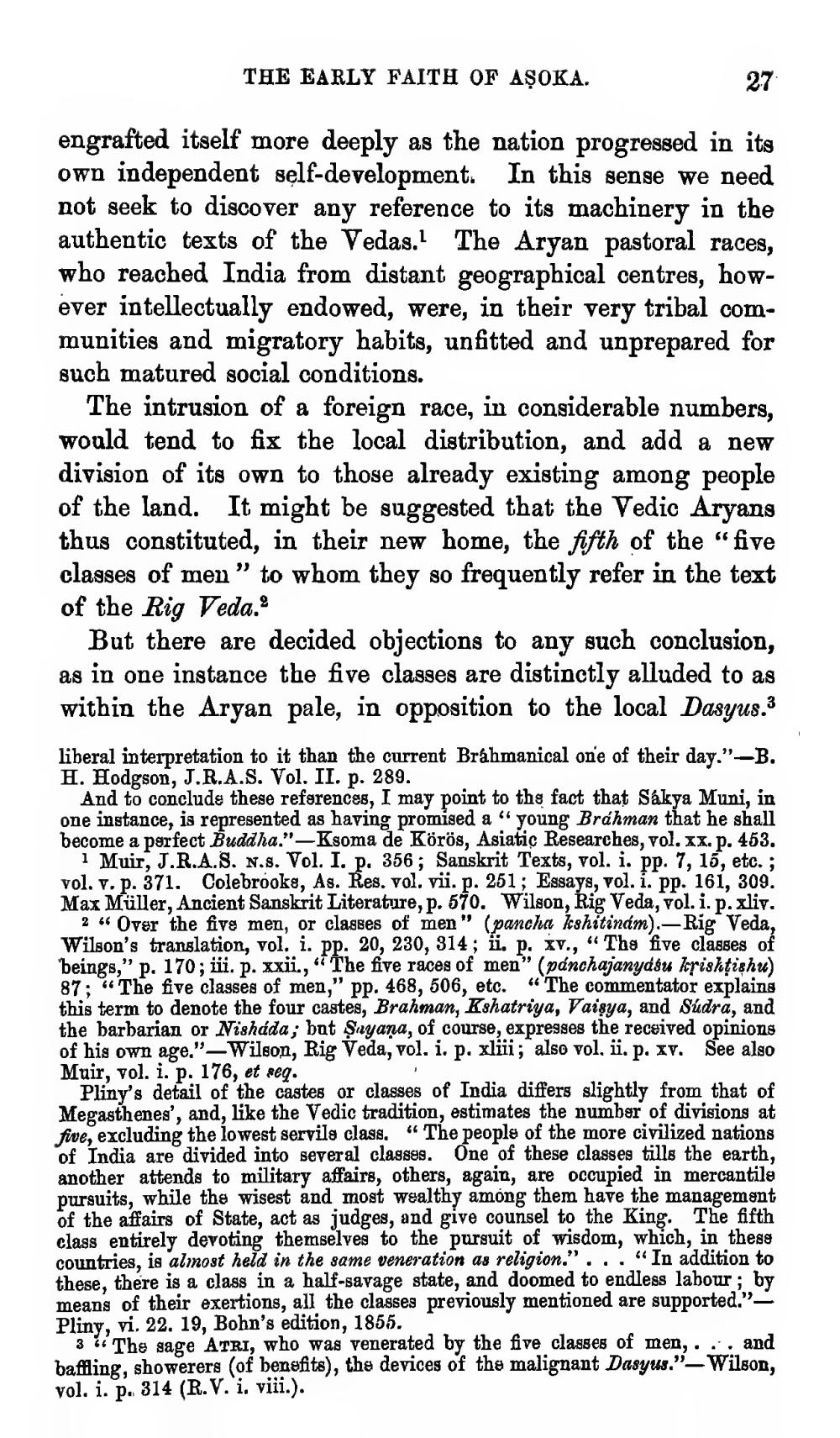________________
THE EARLY FAITH OF ASOKA.
27
engrafted itself more deeply as the nation progressed in its own independent self-development. In this sense we need not seek to discover any reference to its machinery in the authentic texts of the Vedas. The Aryan pastoral races, who reached India from distant geographical centres, however intellectually endowed, were, in their very tribal communities and migratory habits, unfitted and unprepared for such matured social conditions.
The intrusion of a foreign race, in considerable numbers, would tend to fix the local distribution, and add a new division of its own to those already existing among people of the land. It might be suggested that the Vedic Aryans thus constituted, in their new home, the fifth of the "five classes of men " to whom they so frequently refer in the text of the Rig Veda.
But there are decided objections to any such conclusion, as in one instance the five classes are distinctly alluded to as within the Aryan pale, in opposition to the local Dasyus.3
liberal interpretation to it than the current Brahmanical one of their day."-B. H. Hodgson, J.R.A.S. Vol. II. p. 289.
And to conclude these references, I may point to the fact that Sakya Muni, in one instance, is represented as having promised a "young Brahman that he shall become a perfect Buddha."-Ksoma de Körös, Asiatic Researches, vol. xx. p. 453.
1 Muir, J.R.A.S. N.s. Vol. I. p. 356; Sanskrit Texts, vol. i. pp. 7, 15, etc.; vol. v. p. 371. Colebrooks, As. Res. vol. vii. p. 251; Essays, vol. i. pp. 161, 309. Max Müller, Ancient Sanskrit Literature, p. 570. Wilson, Rig Veda, vol. i. p. xliv.
2"Over the five men, or classes of men" (pancha kshitinám).-Rig Veda, Wilson's translation, vol. i. pp. 20, 230, 314; ii. p. xv., "The five classes of beings," p. 170; iii. p. xxii., "The five races of men" (panchajanyásu krishṭishu) 87; "The five classes of men," pp. 468, 506, etc. "The commentator explains this term to denote the four castes, Brahman, Kshatriya, Vaisya, and Súdra, and the barbarian or Nisháda; but Sayana, of course, expresses the received opinions of his own age."-Wilson, Rig Veda, vol. i. p. xliii; also vol. ii. p. XV. See also Muir, vol. i. p. 176, et seq.
Pliny's detail of the castes or classes of India differs slightly from that of Megasthenes', and, like the Vedic tradition, estimates the number of divisions at five, excluding the lowest servils class. "The people of the more civilized nations of India are divided into several classes. One of these classes tills the earth, another attends to military affairs, others, again, are occupied in mercantile pursuits, while the wisest and most wealthy among them have the management of the affairs of State, act as judges, and give counsel to the King. The fifth class entirely devoting themselves to the pursuit of wisdom, which, in these countries, is almost held in the same veneration as religion.". "In addition to these, there is a class in a half-savage state, and doomed to endless labour; by means of their exertions, all the classes previously mentioned are supported."Pliny, vi. 22. 19, Bohn's edition, 1855.
...
3 The sage ATRI, who was venerated by the five classes of men,. baffling, showerers (of benefits), the devices of the malignant Dasyus."-Wilson, vol. i. p. 314 (R. V. i. viii.).
and




